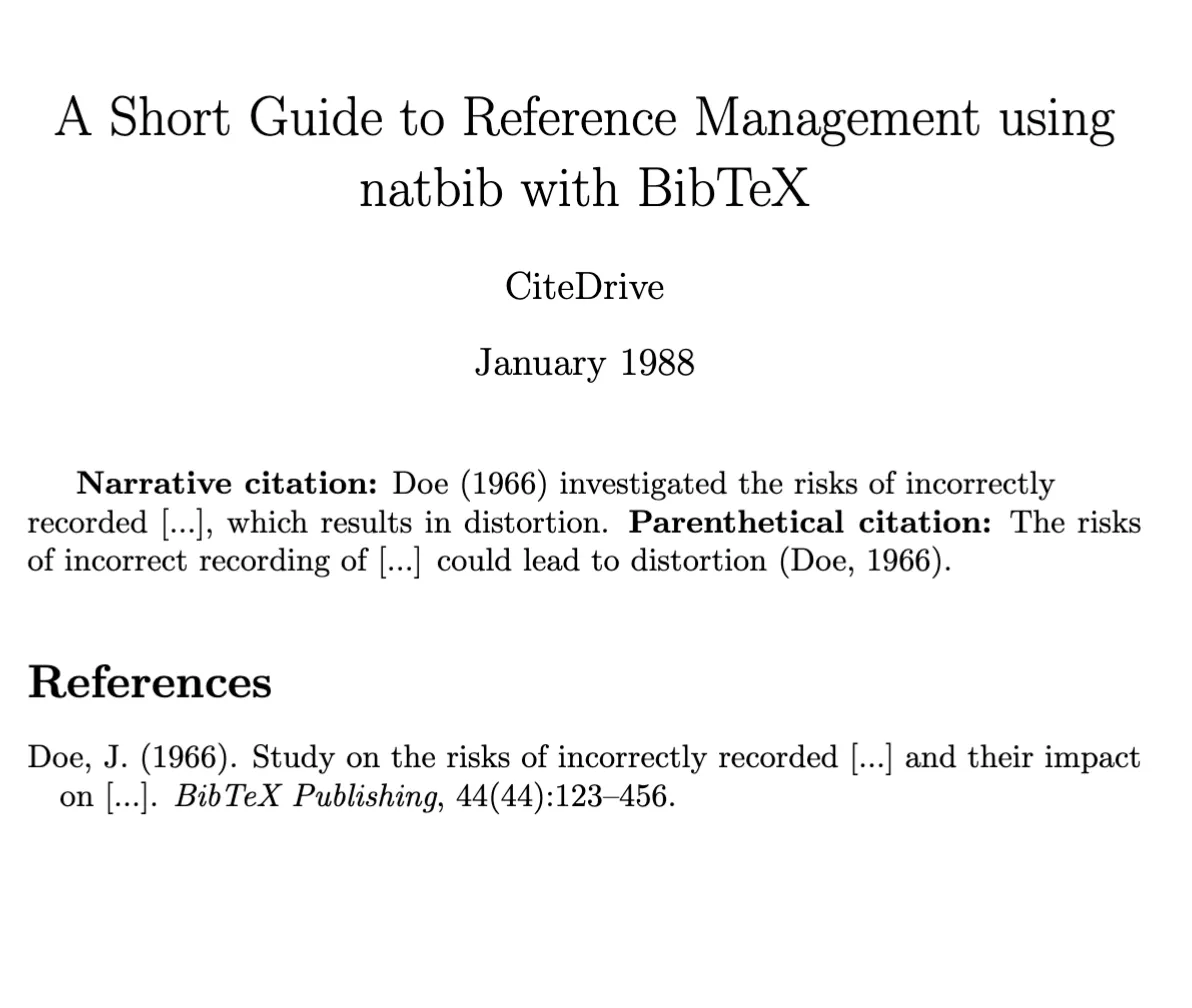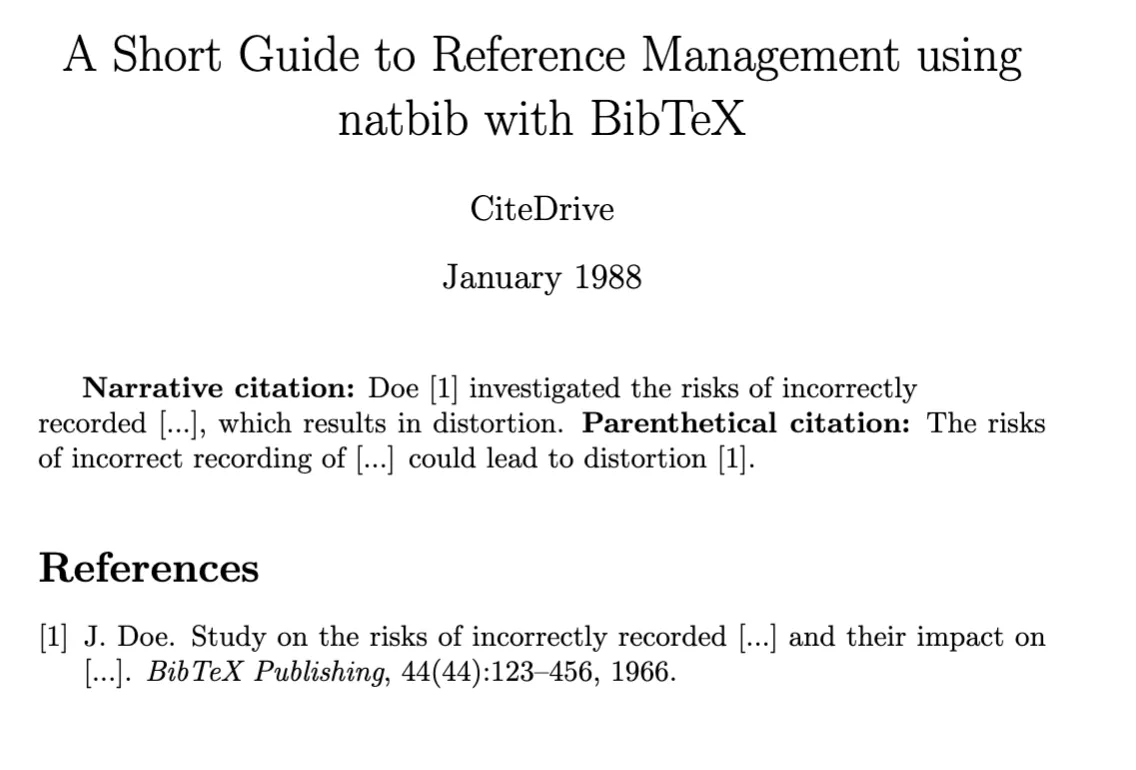Tutoriel Natbib : Maîtriser la Gestion des Références dans LaTeX avec BibTeX
La gestion des références bibliographiques dans LaTeX devient simplifiée et efficace avec le package natbib. Que vous utilisiez la commande traditionnelle \cite{*} ou que vous exploriez des méthodes de citation avancées, ce guide fournit les bases pour vous aider à démarrer.
Introduction à natbib et Ses Forces
Le package natbib étend les capacités de la commande standard \cite{*} dans LaTeX. Il brille particulièrement dans les citations dans le texte avec diverses options et personnalisations, en particulier pour les schémas auteur-année et l’affichage des citations textuelles et parenthétiques lorsqu’il est intégré avec BibTeX.
Voyons les détails de l’utilisation de natbib pour formater et citer vos sources bibliographiques.
Commencez : Citations Parenthétiques et Textuelles/Narratives avec natbib
Configurer natbib nécessite une structure similaire à celle de LaTeX standard. Commencez par charger la bibliothèque en utilisant \usepackage{natbib}. La bibliothèque propose plusieurs options de configuration via \usepackage[options]{natbib}, détaillées ci-dessous. Les principales commandes de citation dans Natbib sont \citet{*} pour les citations textuelles/narratives et \citep{*} pour les citations parenthétiques.
\documentclass{article}\usepackage{natbib}\bibliographystyle{apalike}\title{Un Guide Complet pour la Gestion des Références avec natbib et BibTeX}\author{CiteDrive}\date {Janvier 1988}
\begin{document}
\maketitle\textbf{Citation narrative :} \citet{Doe:1966} a étudié les risques d'un enregistrement incorrect [...]ce qui entraîne une distorsion.\textbf{Citation parenthétique :} Les risques d'un enregistrement incorrect [...] pourraiententraîner une distorsion \citep{Doe:1966}.
\medskip
\bibliography{sample}
\end{document}En utilisant \bibliography{sample}, vous indiquez à LaTeX où se trouve votre fichier .bib, qui contient des entrées bibliographiques comme :
@article{Doe:1966, title = {Étude sur les risques d'un enregistrement incorrect [...] et leur impact sur [...].}, author = {John Doe}, year = 1966, journal = {Édition BibTeX}, volume = 44, number = 44, pages = {123--456}}@article{smith2017, title = {Un article intéressant}, author = {John Smith}, year = {2017}, journal = {Journal des Articles Intéressants}} Exemple de sortie de gestion des références utilisant natbib avec BibTeX
Exemple de sortie de gestion des références utilisant natbib avec BibTeX
Pour ceux qui préfèrent les styles de citation numériques, voici comment adapter natbib :
\usepackage[square,numbers]{natbib}\bibliographystyle{abbrvnat} Exemple de sortie de gestion des références utilisant natbib avec BibTeX en style numérique
Exemple de sortie de gestion des références utilisant natbib avec BibTeX en style numérique
Approfondissement : Exploration des Commandes cite{*} dans natbib
Comprendre la gamme des commandes cite{*} fournies par natbib vous permet de citer les sources efficacement. Ce tableau décompose leurs sorties :
| Commande (citation unique) | Sortie (auteur-année) | Sortie (numérique) | Commande (Citations multiples) | Sortie (auteur-année) | Sortie (numérique) |
|---|---|---|---|---|---|
\citet{Doe:1966} | Doe (1966) | Doe [1] | \citet{Doe:1966,smith2017} | Doe (1966); Smith (2017) | Doe [1], Smith [2] |
\citet[chap.~4]{Doe:1966} | Doe (1966, chap. 4) | Doe [1, chap. 4] | \citet[chap.~4]{Doe:1966,smith2017} | Doe (1966); Smith (2017, chap. 4) | Doe [1], Smith [2, chap. 4] |
\citep{Doe:1966} | (Doe, 1966) | [1] | \citep{Doe:1966,smith2017} | (Doe, 1966; Smith, 2017) | [1, 2] |
\citep[chap.~4]{Doe:1966} | (Doe, 1966, chap. 4) | [1, chap. 4] | \citep[chap.~4]{Doe:1966,smith2017} | (Doe, 1966; Smith, 2017, chap. 4) | 1, 2, chap. 4] |
\citep[see][]{Doe:1966} | (voir Doe, 1966) | [voir 1] | \citep[see][]{Doe:1966,smith2017} | (voir Doe, 1966; Smith, 2017) | [voir 1, 2] |
\citep[see][chap.~4]{Doe:1966} | (voir Doe, 1966, chap. 4) | [voir 1, chap. 4] | \citep[see][chap.~4]{Doe:1966,smith2017} | (voir Doe, 1966; Smith, 2017, chap. 4) | [voir 1, 2, chap. 4] |
\citet*{Doe:1966} | Doe (1966) | Doe [1] | \citet*{Doe:1966,smith2017} | Doe (1966); Smith (2017) | Doe [1], Smith [2] |
\citep*{Doe:1966} | (Doe, 1966) | [1] | \citep*{Doe:1966,smith2017} | (Doe, 1966; Smith, 2017) | [1, 2] |
D’autres commandes natbib, telles que \citealp et \citealt, offrent une flexibilité supplémentaire en supprimant les crochets. Découvrez l’ensemble des commandes dans la Feuille de Référence pour l’utilisation de natbib.
Annexes : Maîtriser les Options pour natbib
Lorsque vous travaillez avec natbib, personnaliser son comportement peut rendre votre flux de travail plus fluide. Voici un aperçu des options disponibles via \usepackage[options]{natbib} :
| Option | Description |
|---|---|
| round | affiche des parenthèses rondes |
| square | affiche des crochets carrés |
| curly | affiche des accolades |
| angle | affiche des chevrons |
| semicolon | les citations multiples sont séparées par des points-virgules |
| colon | identique au point-virgule |
| comma | les citations multiples sont séparées par des virgules |
| authoryear | affiche les citations auteur-année |
| numbers | affiche les citations numériques |
| super | affiche des numéros en exposant pour les citations numériques |
| sort | trie les citations multiples dans l’ordre des références affichées dans la bibliographie |
| compress | les citations numériques multiples sont compressées si nécessaire |
| sort&compress | les citations numériques multiples sont compressées si nécessaire |
| longnamesfirst | le nom complet de l’auteur apparaît dans la première citation |
| sectionbib | redéfinit \thebibliography pour produire \section au lieu de \chapter |
| nonamebreak | affiche tous les noms d’auteur d’une citation sur une seule ligne |
Lectures Complémentaires et Sources
- Plongez plus profondément dans la gestion des bibliographies avec Gestion des bibliographies avec natbib sur Overleaf.
- Familiarisez-vous avec différents styles de bibliographie avec Styles de bibliographie natbib sur Overleaf.
- Pour une feuille de triche pratique, consultez la [Feuille de Référence pour l’utilisation de natbib](https://g
king.harvard.edu/files/natnotes2.pdf).
Conclusion
Exploiter natbib avec BibTeX simplifie la gestion des références dans LaTeX. Ce guide a offert un aperçu complet des configurations de base aux styles de citation complexes. Pour plus d’informations sur LaTeX et ses nombreuses fonctionnalités, explorez notre collection de guides approfondis.